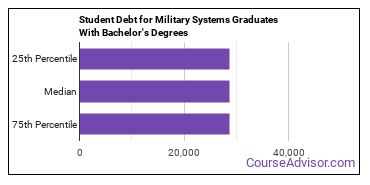Bachelor’s Degrees in Military Systems & Maintenance Technology
Featured schools near , edit
Education Levels of Military Systems Majors
In 2020-2021, 97 bachelor's degrees were awarded to military systems majors. This makes it the 289th most popular bachelor's degree program in the country.
The following table shows the number of diplomas awarded in military systems at each degree level.
| Education Level | Number of Grads |
|---|---|
| Associate Degree | 124 |
| Bachelor’s Degree | 97 |
| Basic Certificate | 8 |
| Undergraduate Certificate | 3 |
| Master’s Degree | 3 |
| Graduate Certificate | 1 |
Earnings of Military Systems Majors With Bachelor’s Degrees
The median salary for graduates holding a bachelor's degree in military systems is $37,861. However, this can depend on a number of factors, such as where you live and the number of years experience you have. A better approximation of salary is to look at the typical range of salaries. In this case the low is $37,861 and the high is $37,861.

Student Debt
The median student debt for graduates holding a bachelor's degree in military systems is $28,625. The school you go to and how long it takes you to graduate, among other things, can cause this number to vary. The chart below shows the range of accumulated debt loads. On the high side of the range, $28,625 is the debt load, and the debt load on the low side is $28,625.

Student Diversity
More men than women pursue bachelor's degrees in military systems. About 84.5% of graduates in this field are male.
| Gender | Number of Grads |
|---|---|
| Men | 82 |
| Women | 15 |

The racial-ethnic distribution of military systems bachelor’s degree students is as follows:
| Race/Ethnicity | Number of Grads |
|---|---|
| Asian | 3 |
| Black or African American | 4 |
| Hispanic or Latino | 7 |
| White | 62 |
| International Students | 6 |
| Other Races/Ethnicities | 15 |

Most Popular Military Systems Programs for Bachelor’s Degrees
There are 2 colleges that offer a bachelor’s degree in military systems. Learn more about the most popular 2 below:
The most popular school in the United States for military systems students seekinga bachelor's degree is Liberty University. Roughly 93,300 attend the school each year. The average in-state tuition for full-time undergraduates is $15,409 per year, while in-state graduate students, on average, pay $7,847 per year. During the 2020-2021 academic year, 65 people received their bachelor's degree in military systems from Liberty University. Of these students, 2% were women and 14% were members of underrepresented racial-ethnic groups.
The 2nd most popular school in the country for military systems majors who are seeking their bachelor's degree is Embry-Riddle Aeronautical University - Daytona Beach. Roughly 8,700 attend the school each year. The average in-state tuition for full-time undergraduates is $37,512 per year, while in-state graduate students, on average, pay $18,756 per year. The military systems program at Embry-Riddle Aeronautical University - Daytona Beach awarded 32 bachelor's degrees during the 2020-2021 school year. About 44% of this group were women, and 19% were students from an underrepresented racial-ethnic group.
Explore Major by State
Alabama
Arkansas
Connecticut
Florida
Idaho
Iowa
Louisiana
Massachusetts
Mississippi
Nebraska
New Jersey
North Carolina
Oklahoma
Rhode Island
Tennessee
Vermont
West Virginia
Related Majors
Below are some popular majors that are similar to military systems that offer bachelor’s degrees.
| Major | Annual Degrees Awarded |
|---|---|
| Intelligence & Command Operations | 1,260 |
| Military Applied Sciences | 115 |
| Other Military Technology & Sciences | 66 |
| 22 |
References
*The racial-ethnic minority student count is calculated by taking the total number of students and subtracting white students, international students, and students whose race/ethnicity was unknown. This number is then divided by the total number of students at the school to obtain the percentage of racial-ethnic minorities.
More about our data sources and methodologies.
Featured Schools
 Request Info
Request Info
|
Southern New Hampshire University You have goals. Southern New Hampshire University can help you get there. Whether you need a bachelor's degree to get into a career or want a master's degree to move up in your current career, SNHU has an online program for you. Find your degree from over 200 online programs. Learn More > |



